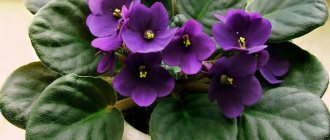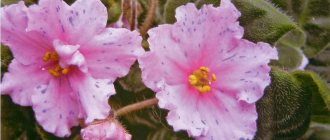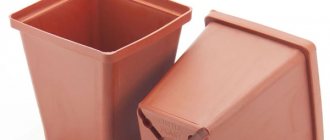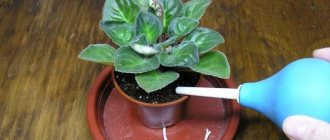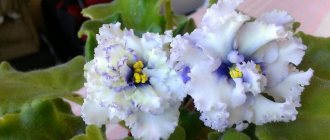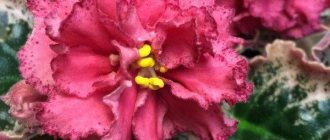Types of Saintpaulias and their care
Caring for Saintpaulia is simple, the plant forgives even one or another mistake.
Saintpaulia is one of the most popular houseplants due to its vibrant flowers and richly colored leaves. In addition to the 11 natural species in this genus, there are countless hybrids. If the Saintpaulia is well cared for and given the right conditions for the plant, it will grow and bloom all year round. In bright rooms with high humidity, these beautifully flowering plants do very well.
By now, you can choose from hundreds of varieties of Uzambara violets. These plants are especially intensively bred in the USA. In Europe and Russia their variety is not so great, but you can find about 40-60 varieties in trade. When Saintpaulias are grown in good conditions, the plants will bloom and develop throughout the year.
Home care
Lighting
In order for Saintpaulia to bloom all year round, it must be provided with 14 hours of daylight. There should be a lot of light, but it should be diffused. The scorching rays of the sun lead to burns and drying out of the plant.
Temperature
Saintpaulia requires a stable temperature. Differences of several degrees between morning and night temperatures are allowed. The optimal thermal range for keeping Saintpaulia is 16 - 25 degrees.
The flower does not like winds, so you should not keep the plant in a draft or take it out onto loggias and balconies.
Watering and humidity
Saintpaulia should be watered exclusively with settled water at room temperature. In this case, the watering procedure is carried out either through a tray, or so that the water only falls on the soil around the plant.
If the room temperature is high, then water the flower twice a week. At low temperatures, one watering every 7-8 days is sufficient.
Wild Saintpaulias grow in very high humidity; they are accustomed to being in the water dust of waterfalls and in mountain fog. Therefore, house flowers also require high air humidity. Do not spray the plant with water! The humidity in the location of the Saintpaulia pot should be increased by using moisturizers (wet pebbles, containers of water, electric humidifiers).
Priming
For growing Saintpaulia, ordinary garden soil mixed with a small amount of river sand (3:1) is suitable. You can also find ready-made substrates for Saintpaulia in flower shops.
When making your own earthen mixture, garden soil must be sterilized in the oven or rinsed several times with boiling water.
The bottom of the container for Uzambara violet must be covered with a good drainage layer.
Fertilizers
In the spring, for more luxuriant leaf growth and abundant bud formation, the soil should be fertilized with liquid mixtures that contain phosphorus, nitrogen and potassium. It is enough to feed the plant for several months at intervals of once every 15 days. For most of the year, Saintpaulia does not need fertilizer.
Transfer
Saintpaulia needs to be replanted every year and only in March, before the start of the growing season.
Saintpaulia's root system has one feature - it is constantly renewed - old roots die off, and new ones grow. This contributes to the deterioration of the quality of the substrate and causes the appearance of fungal diseases. Therefore, replanting is carried out not to increase space, but to renew the soil.
However, you should not change the size of the pot. The container for Saintpaulia should be very compact, so that the young roots can tightly weave the entire space.
Saintpaulia ionantha
Saintpaulia violetflower (hybrids of S. Ionantha) grows like its herbaceous parent plant with short shoots and a flat rosette. The soft, dark green and hairy leaves are heart to oval shaped. The leaves can be up to 7 cm long and 3 cm wide. The underside of the leaves sometimes has a reddish glow. The length of the petioles is about 6 cm. Saintpaulia ionantha reaches a plant height of 5 to 10 cm and a diameter of 10 to 25 cm.
Varieties and Species
Saintpaulia has about twenty species of plants.
The most famous types:
- Saintpaulia confusa is a plant with a slender, straight stem up to 10 cm high. The flowers are bluish-violet, with yellow anthers, collected in racemes of four.
- Saintpaulia violetflower , or Saintpaulia ionantha - in nature the plant has violet-blue flowers, but in bred cultivars the color can be very diverse: white, pink, red, blue, purple. The leaves are green above, greenish-reddish below.
- Saintpaulia magungensis - . A plant with branched stems up to 15 cm high and leaves about 6 cm in diameter with wavy edges. The flowers are purple, collected in twos or four.
- Saintpaulia teitensis. A rare species from the mountainous regions of south-eastern Kenya, subject to protection.
Currently, many varieties of Saintpaulia have been bred, most of them are hybrids. For such hybrids, violet growers often use the designation Saintpaulia hybrida .
Saintpaulia varieties are divided into several groups, primarily based on the color and shape of the flowers and their type. According to this principle, classic, star-shaped, fantasy, bordered Saintpaulias and “chimera” Saintpaulias are distinguished.
Based on the type of leaves, plants are primarily distinguished as “boys” and “girls”. The “girl” plants have a light spot on the upper side at the base of the leaf, while the “boy” varieties have completely green leaves.
Saintpaulia ionantha ssp. grandifolia
S. ionantha ssp. grandifolia produces much thinner and larger leaves than most of the rosette-forming species described here.
The oval leaves have a sawtooth edge and about 10 cm long stems. One sheet up to 10 cm long and 8 cm wide.
The up to 7 cm long stems can bear up to 20 dark purple flowers. The diameter of the flowers is about 2 cm.
Saintpaulia ionantha ssp. Grotei
Saintpaulia ionantha ssp. grotei is considered the generic form of many pendulous forms of Usambara violets. The creeping, branched stems of this species grow up to 20 cm long. The almost round leaves are slightly serrated at the edges and covered with short, fluffy hairs. Petioles up to 25 cm long. Flowering shoots, about 15 cm long, form two to four flowers. Which are purple-blue around the edges and dark purple in the middle.
Saintpaulia violet flower miniature (miniature Usambara violet)
Miniature Usambara violets are a variety of the South African species S. Ionantha. Like the original species, the miniature forms grow with a flat-appearing rosette, soft and slightly hairy leaves, ranging from oval to heart-shaped. Leaf colors vary among cultivars and range from dull green to dark green and bluish purple. The central leaf axils produce ascending flower stalks with slightly branched peduncles, each bearing 3 to 5 simple to full flowers in the colors white, pink, red, blue and purple.
Place for Saintpaulia, lighting for Saintpaulia
All Saintpaulias need a well-lit and very bright place. In summer, plants should not be exposed to direct sunlight, otherwise the flowers and leaves will get burned. However, diffused, indirect sunlight or lighting through tinted glass will suit her. Saintpaulia requires year-round light intensity of at least 1500 to 5000 lux.
Eastern or western flower windows are well suited for Saintpaulias. South-facing windows are also suitable places for them, but the strong sun should be greatly reduced here by curtains, sun-loving plants or the like. Trees or shrubs growing close to a south-facing window will usually serve the same function well, as long as they prevent the strong afternoon sun from shining through the window.
During the summer, adequate lighting is not a problem unless you place the plant in a dark corner of the room. During the fall and winter season, you should check the light values because Saintpaulia will quickly stagnate in areas with poor light.
In this case, you can hang lighting above the plants. Phytolamps are turned on for twelve hours a day. With sufficient lighting and good care, Saintpaulia will bloom without interruption.
Watering Saintpaulia
During the main growth phase, Saintpaulia is watered sparingly.
Moderate watering of Saintpaulia
- Before watering, let the top layer of the substrate dry to a depth of about 1 cm. Testing with your finger in this case works well (or you can buy (on Aliexpress) and use such a device - ]]>https://ali.pub/27q8r1]]>) . When the top layer of the substrate dries well, watering is carried out. Inside the pot, the soil remains evenly moist; the substrate should not dry out completely.
- When you water, you give just enough water to keep the earthen ball evenly moist, but not oversaturated with water.
- As soon as the first drops of water run out of the drainage hole, stop watering. Excess water is poured out after 20 minutes.
Since the core or leaves of Saintpaulia are not allowed to get wet, it may be easier to water the plants through a tray. To do this, you pour some water into the stand and wait until it is all absorbed. This is repeated several times depending on the size of the pot. There should be no water left in the pot stand.
It is advisable to use only warm, soft tap water or rainwater for irrigation. Usambara violet is a humus root. Lime and cold water damage plants. When watering Saintpaulia with tap water, this happens quickly, usually due to the pH value being too high (> 6.5) and/or the water hardness being too high.
If you do not have the opportunity to collect rainwater, you should use an ion exchanger (for example, you can buy one (on Aliexpress) - ]]>https://ali.pub/27srvb]]>) to soften the water for irrigation.
If the room temperature drops below 16°C for several days, you will need to limit watering until the contents of the pot are 2-3cm dry.
Tips for growing Saintpaulia
- Lighting and arrangement of the flower.
The plant does not tolerate direct sunlight; soft and diffuse lighting is most suitable for Saintpaulia. It is better to place a flower pot on windows with western or eastern exposure, where the sun's rays only shine for a short time. The bush will grow well under artificial light. If the Uzambara violet is on the windowsill of a south window, then you will have to arrange shading so that the decorative properties of the flowers and leaves do not deteriorate. To do this, it is recommended to cover the windows with light fabrics or gauze; you can stick paper or tracing paper on the window - this will diffuse the bright light. - Temperature of keeping Saintpaulia.
Room heat indicators are most suitable when growing a flower. In the summer, the thermometer should show from 20 to 25 degrees; with the arrival of autumn, the temperature should be lowered to 15 degrees and no lower. If it gets too hot, Saintpaulia stops blooming and slows down its growth. It is necessary to ensure that the plant is not exposed to sudden changes in temperature and is not exposed to drafts.
- Humidity for successful cultivation
of Uzambara violet should be between 50% and not higher than 70%. It is not advisable to spray the bush, since the leaf blades have pubescence, and if drops of moisture get in, they can begin to deteriorate and rot. It is better to solve the problem of dry air by using air humidifiers or placing a flower pot in containers filled with moistened expanded clay or pebbles. You just need to make sure that the bottom of the pot does not stand in water, so that the roots do not rot. If the plant is located above central heating radiators during the heating season, it is recommended to place a dampened towel on them so that dry and hot air does not damage the Saintpaulia. - Watering Saintpaulia.
When moistening the plant, it is necessary to focus on the condition of the soil in the pot. When its top layer dries out, you can water the flower - this usually happens once every 2-4 days. The soil should be constantly moist, but the water in the stand under the pot is always drained. You cannot overwater the plant; this can cause rotting of the root system, especially at low temperatures. It is important that when watering, water does not get into the leaf rosette, as the stems and leaves will begin to rot. It is necessary to moisten along the edge of the pot. Also, if you have no watering experience, then you can carry out “bottom” watering, when the pot with the plant is placed in a bowl of water for 15 minutes, and when the Saintpaulia has collected the moisture it needs, it is removed. For irrigation, use only soft water with a moderate temperature (about 20–23 degrees). It is recommended to use rain or melt water; it is heated a little. But if this is impossible to arrange, then you will have to filter the tap water, boil it, and then let it sit for several days. - Fertilizing
is carried out for Saintpaulia from the beginning of spring days to the end of autumn. Choose liquid complex fertilizers in a concentration reduced by half. The frequency of this operation is once every 14 days. - Transplanting Saintpaulia and choosing soil.
In order to change the pot to a new one, you need to choose a wide container of small height. The size of the pot should correspond to the volume of the bush. If the plant has only a few leaves, then planting is done in a container with a diameter of 5–7 cm. After six months, you can change the container to 9 cm in diameter. If the variety is miniature, then you should choose bowls with a diameter of 3–4 cm - usually these are pots for small cacti. The height of the container should ideally match the width, since the plant does not grow deep with its roots. To accurately determine the size, there is a rule: the leaves of a Saintpaulia bush planted in a pot should extend beyond the container by half the length or a little more. If the pot is chosen incorrectly and it is too large, then there is a high probability of flooding and waterlogging of the substrate. The soil will not dry out for a very long time, and this will lead to pests starting to appear: fools, multi-tailed gnats or fungus gnats. The pot should have drainage, approximately 1/5 of the total volume of the container, and holes to drain excess moisture.
To select soil for replanting, you can use ready-made substrates for violets, which are sold in flower shops. The soil reaction is slightly acidic with a pH of 5.5-6.5. The soil should be light, moisture-absorbing, with sufficient air permeability, nutritious and contain phosphorus, potassium and nitrogen. You can create a soil mixture yourself based on the following options:
- leaf soil, turf soil, coniferous substrate, coarse sand, vermiculite (in proportions 2:1:1:1:1);
- leaf soil, coconut shavings (briquette substrate), rotted humus flour, well-crushed pine bark (in a ratio of 2:1:1:0.5);
- turf, coniferous soil, vermiculite (or agroperlite), coarse river sand (in proportions 1:1:1:0.5);
- store-bought “Violet” soil (you can take universal soil for indoor plants), perlite or vermiculite, chopped sphagnum moss or well-grained pine bark (5:1:1:1 ratio).
Air humidity
High humidity is important when caring for Uzambara violets. Therefore, place the pots in bowls filled with water on pebbles (details shown in the picture). With sufficiently high air humidity, the plants bloom well and develop well, provided that the other care needs of Saintpaulia are met at a sufficient level.
Outside the heating season, natural humidity is sufficient for most plants. However, in winter, when the heating is turned on, the humidity in our apartments drops significantly.
This is especially problematic when the plant is located near a radiator during the heating season. Using a weather station or a simple hygrometer, you can measure the moisture content in the air; if necessary, you can increase the humidity with evaporators (you can order this inexpensive hygrometer-thermometer on Ali - ]]>https://ali.pub/27tk6z]]>). Do not spray water on Saintpaulia leaves.
There is a problem - there is a solution
Problems in caring for Uzambara violet and their solution: Light spots on the leaves are sunburn. Shade the window or move the flower to another window sill. Pale green spots on the leaves in winter indicate that the plant is cold. Remove it from the window, avoid drafts. Lack of flowering for a long time - lighting is not suitable for Saintpaulia, there is not enough fertilizing or the pot chosen is too large. Place the flower in a bright, but not hot place, and periodically feed it with fertilizers for violets or flowering ornamental plants.
Transplant the bush into a pot whose diameter does not exceed the diameter of the leaf rosette. Mold on leaves and flowers indicates frequent exposure to water on the plant. Violet does not like high humidity and spraying. Remove the affected parts of the bush and treat it with a fungicide. The appearance of pests: scale insects, spider or cyclamen mites, thrips, nematodes, mealybugs, aphids. Treating the plant, the soil in the pot, and the window sill with drugs that affect specific types of pests can help. These are “Aktellik”, “Agravertin”, “Fitoverm”, “Mospilan”, etc. In some cases it is necessary to destroy the plant.
Wintering of Saintpaulia / Dormant period
Uzambara violets do not have a rest period and grow all year round. However, due to lower light levels and shorter days during the winter months, plant growth is significantly slower. If Saintpaulias are supported with sufficient lighting in winter (from 1500 to 5000 lux), they will grow and bloom throughout the year.
In winter, the temperature should not fall below 18°C.
To be able to correctly assess the moisture content inside the pot, a moisture meter for indoor installations is needed. This is especially true for large breeders.
We posted a link to a simple and inexpensive device above. You can also buy moisture meters at hardware and garden stores.
Description of the plant
Saintpaulia violet (Saintpaulia) is a herbaceous, evergreen, flowering, perennial plant from the Gesneriaceae family. In nature, it is found only in the mountainous regions of Kenya and Tanzania. Prefers high humidity and occupies areas near streams, mountain rivers and waterfalls.
Leaf petioles-stems are collected into a rosette at the apex of the root. The leaves are large, with dense skin and dense pubescence. The shape of the leaf plate is a wide oval, with slight asymmetry. The foliage color is dark green. However, Saintpaulia bushes are bisexual, and a female bush can be distinguished from a male bush by a light spot at the base of the leaf blade.
The Uzambara violet blooms almost all year round. The flowers are collected in tassels, 3-6 pieces each. Each flower has five petals. The size, shape and color of the flowers are very diverse and are determined by the varietal type of the plant. Flowering ends with the formation of a seed capsule.
Reproduction of Saintpaulia (Uzambara violet)
Saintpaulia can be easily propagated from leaf cuttings. For this, mature and healthy leaves are taken. The petiole of the bush is cut to 2 cm and planted in a pot in a moist substrate to a depth of 12 mm to 15 mm. A mixture of peat and sand or peat-based soils are best suited for this crop.
To ensure sufficiently high humidity during root formation, cover the pot with a plastic bag. Alternatively, an openable expansion box is used directly.
To form new shoots, you need a bright but not sunny place and a temperature between 18 and 24 ° C. At this time, water very little or not at all, the substrate should not dry out and should always be slightly moist.
After 8-10 weeks, a small plant appears at the base of the petiole and appears on the surface of the earth. Over the next 2 months, the small young seedlings gradually open for longer and longer periods until they are fully adapted to the normal environment. At this time, water lightly so that the soil does not dry out. Apply commercially available liquid fertilizers in low concentrations once a week.
As soon as the plants grow from 3 to 5 cm, they are carefully separated from the old leaf, and planted separately in pots with a diameter of 5-6 cm. The plants can now be cultivated as adult specimens.
Saintpaulia cuttings can also be rooted in water. Once the roots have grown to a length of 2 to 3 cm, the plants are placed in pots with the recommended substrate.
Classification of varieties of indoor violets
There are many varieties of violets, varying in size, flower shape, number and color of petals. Moreover, the same variety can belong to several groups. Now we will try to understand the classification of indoor violets.
According to socket size
Micromini . They have a rosette diameter of up to 8 cm. Against their background, ordinary Saintpaulias with a diameter of 20-40 cm look like giants. They are grown only in compact pots with wick watering. Otherwise, the risk of them drying out is too high - if left without moisture, they dry out and die quite quickly.
Mini . The diameter of the rosette of such a violet does not exceed 12-15 cm. Just like microminis, they are grown, most often, with wick irrigation. They tolerate propagation well and therefore take root faster than larger varieties. During flowering, they form many attractive, bright and original inflorescences.
Half mini . They have a rosette diameter of up to 20 cm. Most of these varieties were bred with the participation of the domestic botanist Igor Milekhin. It is important to know that excess light is harmful for semi-mini violets! In a short time, all the foliage may turn yellow, and the rosette becomes flat in shape.
Standard - rosette 20-40 cm in diameter.
By flower size
Based on flower size, violets are divided into the following groups:
- small-flowered - up to 2 cm;
- medium-flowered - from 2 to 4 cm;
- large-flowered - from 4 to 6 cm;
- especially large-flowered - more than 6 cm.
Types by flower shape
Depending on the size and location of the petals, there are 5 types of indoor violets:
- Pansies;
- Star;
- Bell;
- Bowl;
- Wasp.
This may be interesting: Crossandra - care and reproduction at home
Let's get to know them in order.
Pansy (Pansy)
The five petals on the flower are arranged in two rows. In the top row there are two smaller petals, and in the bottom row there are three larger ones. In this group of violets we highlight the following varieties:
Lyon's Pirate's Treasure. Breeder S. Sorano.
Violet Liens Pirates Treasure has bright pink flowers with a wide crimson edging around the edge. Along the border of the main color and the border, the petals are strewn with a scattering of small dark crimson dots. The rosette consists of leaves with a bubbly texture.
Cinderella's dream
Saintpaulia Cinderella's Dream has large, semi-double, lacy flowers of light purple color with a crimson tint. Purple-violet patterns run across the petals. The top two petals are smaller and darker in color than the bottom three. Their edges are greenish and fringed. The border is corrugated. The rosette consists of dark green, evenly colored wavy leaves.
Melody Kimi. Breeder Sunnyside/Levy.
The Melody Kimi variety has a symmetrical rosette made of “quilted” wavy leaf plates. A white simple violet flower has two blue upper petals and a border of the same color on the main background.
Star
It is distinguished by the same size of all petals and their uniform arrangement around the center of the flower. In this group of violets we will introduce you to the following varieties:
Kev's Heavenly Star. Breeder K. Degner.
Kev's Heavenly Star violet has the appearance of a simple semi-double pink star with a wide dark fuchsia border.
Goddess of beauty. Breeder E. Korshunova.
The violet variety Goddess of Beauty has a large rosette of dark green leaves. The inflorescences display bright double flowers - pink stars with tints of purple-violet tones.
Magic of Love. Breeder E. Korshunova.
The magic of love . This large-flowered violet has densely double star-shaped flowers, shaped like pompoms, painted in burgundy color with a beet tint. The edges of the petals are decorated with elegant white edging. The rosette consists of beautiful green leaves.
Black Prince
Saintpaulia Black Prince has large dark red double flowers in the shape of a star. The standard-sized rosette consists of dark green foliage, red on the underside.
Rosemary. Breeder E. Lebetskaya.
Saintpaulia Rosemary has a standard rosette of dark green leaves with serrated edges. And star-shaped double flowers combine several bright touches at once. Their notched petals are gracefully ruffled, and the white background is wonderfully painted with touches of pink and splashes of blue at the same time.
Marshmallow
Zephyr has double or semi-double flowers with large, creamy-white petals, on the surface of which coral or pink strokes are scattered. The edges are wavy. Peduncles are large and erect. The large but compact rosette of this Saintpaulia variety consists of light green leaves. The plant grows quickly. It does not like high temperatures, at which it begins to bloom with simple white flowers.
Austin's Smile. (Austin's Smile). Breeder LLG / P. Sorano.
Austin's Smile has a large rosette of dark green leaves and large single star flowers of coral pink color with a dark pink eye and crimson edging.
Bell
It is distinguished by petals fused at the base. This feature prevents the flowers from opening completely, as a result of which they acquire a resemblance to bells. We will present this species with the following varieties of indoor violets:
EK-Admiral. Breeder E. Korshunova.
Violet Admiral has large cornflower blue semi-double bell flowers with wavy edges. The pointed, dark green leaves of this Saintpaulia have a creamy-purple edge.
Shining bell
The flowers of the Shining Bell bloom in the form of blue bells with wavy edges. They show rare touches of fantasy. There is a bright yellow eye in the center. A regularly shaped rosette of green leaves.
Sea wolf. Breeder E. Korshunova.
A large rosette consists of dark green fleshy leaves. The flowers are also large, up to 8 cm in diameter, blue. The corollas are semi-double, shaped like bells. The wavy petals of the Sea Wolf at the stage of full bloom are decorated with an elegant mesh pattern.
Chanson
Violets of the Chanson are unpretentious, bloom profusely and for a long time. Double flowers look like bells. They consist of a huge number of violet-purple or dark blue velvety petals, playing in the light with various shades. In addition, the wavy petals have light or dark pink spots. A large, symmetrically growing rosette consists of smooth, shiny, dark green leaves.
Rob's Dandy Lion. Breeder R. Robinson.
Saintpaulia Robs Dandy Lion has a rosette consisting of dark green leaves with slight variegation, and large bell-shaped inflorescences of a greenish-cream hue, reminiscent of snowdrops in shape.
Bowl
It differs in that the petals that are not fused at their base still do not allow the flower to fully open. The flower retains its cup shape throughout its flowering period. In this group the following varieties of indoor violets can be distinguished:
Boo Man. Breeder S. Sorano.
Boo Man (Boo Man) has double or semi-double cup-shaped flowers of a soft blue color. The upper petals are usually white, sometimes slightly greenish, up to 3 cm in diameter. The leaves are dark green, oval, spoon-shaped.
Ming Dynasty. Breeder I. Fredette.
Ming Dynasty . This Saintpaulia is distinguished by its heavily ruffled, cup-shaped, snow-white flowers with pink or lilac edges. There are double and semi-double specimens. The rosette consists of wavy variegated leaves.
This may be interesting: Violet or Saintpaulia - home care
Wasp
It is distinguished by completely separated petals, two of which are rolled into a tube, and three, elongated, hang down. This group includes the following varieties of indoor violets:
Lunar Lily White
Lunar Lily White variety has a small rosette of light green leaves with a “quilted” texture. Its inflorescences consist of 3 - 8 white simple and semi-double flowers about 4 cm in diameter.
PL-Zemfira. Breeder L. Beekeepers.
Zemfira has a medium rosette of green leaves, variegated in the center. Single or semi-double lilac tubular flowers have ruffled edges.
Satellite (Spootnik). Breeder J. Dates.
Saintpaulia Sputnik has a small rosette (about 15 cm) of light green leaves up to 5 cm long. The flowers of this violet are red-violet in color.
By degree of terry
Also, varieties of violets can be divided according to the degree of terryness or the number of petals. On this basis, all violets are divided into the following groups:
- Simple (5 petals).
- Comb type is a type of semi-double Saintpaulia, in which, in addition to five petals, there are 1 - 3 additional underdeveloped ones.
- Semi-double is when the peduncle has more than 5 but less than 10 petals, most often 7-8. In this case, the stamens are clearly visible.
- Terry is a type of violet in which the number of petals exceeds 10. There are so many of them that they cover the stamens.
- “Carnations” are Saintpaulias, the flowers of which are similar to double ones, but larger, with more petals on the peduncle. In appearance, such Saintpaulias really resemble carnations, hence the name.
Along the edge of the petal
The petals of Saintpaulia are wavy, notched and fringed.
By color
Indoor violets, based on the color of the petals, are divided into plain and painted in two or more colors.
Plain
This type of Saintpaulia has only one color of petals. The colors can be very different: white, yellow, orange, pink, red, blue and even green. For example, " Blue Teal Fly ".
Blue Tail Fly. Breeder J. Dates.
This violet has bright blue flowers with tubular upper petals and elongated lower petals. The rosette consists of fleecy leaves rolled into “balls”. Using this variety as an example, it becomes clear that one variety can belong to several classifications. Blue Tail Fly Applies to both “Wasp” and “Solid” violets.
Gillian. Breeder D. Ferguson.
Gillian's violet has a rosette of rounded "quilted" green leaves up to 40 cm in diameter. White large double flowers, resembling a carnation in shape.
Two-tone
These indoor violets have two shades of the same color on their petals. They can be in the form of shadows, rays or thickening of color from the center to the edge.
Marie-Sylvia. Breeder M. Tremblay
The violet variety Marie-Sylvia is characterized by simple and semi-double light lilac flowers with pronounced dark lilac tips of the petals. Moreover, on the two upper petals the darkening is stronger than on the lower ones.
Rum Punch, or Rum Punch. Breeder S. Sorano
Rum Punch is a variety of rare beauty, with characteristic large semi-double and double flowers resembling a star in shape. The edges of the petals are wavy, ash pink, and are set off by the deeper mauve lower petals.
Two-color or multi-color
These violets are distinguished by a border that contrasts with the main color.
Iceberg. Breeder S. Sorano.
This Saintpaulia variety is characterized by semi-double and double star-shaped flowers with a thin blue ruffled border. The border is always clear, as if drawn with a pencil. But Iceberg has a tendency to darken its color towards blue; over time, the flowers can become simply purple or blue.
In some cases, violets have two borders. Here are some examples of such varieties:
Looking Glass Through the Looking Glass. Breeder S. Sorano
Through the Looking Glass is a very unusual and unlike other violet. It has semi-double light pink ruffled flowers with a raspberry-fuchsia edge and a very thin white-green edge.
Limbed
Rose of Wind. Breeder E. Lebetskaya.
Compass Rose flowers resemble graceful garden roses with pale pink petals. Toward the curled fringed edges, the color thickens, and the edging becomes crimson, and, in places, green. The picture is complemented by wavy, light green rosette leaves.
Natalia's Extravagante. Breeder N. Pineault.
Natalis Estravagante has lacy flowers of white and pink color with a border, the tone of which can be pink, green or chocolate. The rosette consists of green leaves with pink and white streaks along the edges.
Beautiful Creole. Breeder E. Lebetskaya.
A very unusual plant, prolific and unpretentious. The small compact rosette of the Beautiful Creole is strewn with many simple but very effective dark blue velvety flowers - stars, the edges of the petals are outlined with a contrasting white edging. The diameter of the flower reaches 5 cm. The strong stem is burgundy in color.
Macho. Breeder E. Lebetskaya.
This is a large-flowered variety of standard sizes, delighting gardeners with a lush cap of large semi-double flowers. The corollas of the Macho violet have a pronounced star shape and are colored in a thick burgundy-violet color. The wavy edge of the petals is set off by a contrasting white border. The rosette consists of simple oval-shaped green leaves.
Modern Talking. Breeder E.A. Arkhipov.
Modern Talking - Violet with white semi-double frilly pansy flowers edged in pink-blue-violet. The rosette consists of light green flat leaves.
This may be interesting: Camellia in an apartment - growing and care
Finger color
These varieties of violets look as if they dipped their finger in paint and stained the flowers with it. Such “prints” are most often located in the middle of the petal, but can also be located closer to the edge.
Crimson Ice or Raspberry Ice. Breeder P. Sorano
Crimson Ice or Raspberry Ice has simple white pansy-type flowers with crimson-red spots on the petals that are brighter and more saturated on the lower three leaves.
Also, violets can have random strokes and spots on their petals. It looks as if the edge of the flower was dipped in paint. Moreover, on the same bush, some flowers may have such spots, while others remain monochromatic.
Southern Springtime (Mac's Southern Springtime) or Southern Spring. Breeder G. McDonald
For example, Southern Spring . This semi-miniature violet bears single to semi-double, wavy, cup-shaped flowers of white with contrasting random patches of light to almost black red. At the same time, each flower is unique and has its own pattern.
Peephole
The so-called eye looks like a round spot in the center of the flower. It can either match the main color or contrast with it.
EK-8 March
EK-8 March has huge single and semi-double white star-shaped flowers with a wavy-fringed edge and a raspberry-pink center.
Mesh
This is a pattern consisting of veins, similar to a mesh. Examples of this color can be found in other flowers, for example, in streptocarpus, but for violets it is quite rare.
Feather or Feather. Breeder I. Fredette.
The feather is a medium-sized pansy-type Saintpaulia. It has white flowers with corrugated edges and a blue pattern over the entire surface of the petal, more like lace.
Granger's Carnival. Breeder J. Eyedom.
The Granger's Carnival variety is characterized by simple flowers with a blue-violet mesh pattern. The edges of the petals are white with a clear venous pattern.
Chimera violets
They may have stripes of different colors, diverging from the center of the petal to its edges. Here are some typical varieties.
Chain Reaction. Breeder S. Sorano.
Chain Reaction is distinguished by the fact that a light lilac stripe runs down the center of the pink petals of its flowers. Lilac inclusions are scattered over the entire surface of the petals. The rosette is standard and consists of green leaves.
Queen Sabrina. Breeder P. Sorano.
Saintpaulia Queen Sabrina has double, coral-colored flowers with purple stripes on each petal. The rosette consists of small dark green leaves.
Here are photos of several more varieties of chimera violets:
Humako Sharon Lyon's Fortuner Teller
Yukako
Fantasy
Chimpansy. Breeder E. Fisher.
Chimpansi is a beautiful variety. It is distinguished by a small green rosette composed of slightly jagged green leaves. Semi-double pink star flowers have a white wavy border along the edge. Violet petals are strewn with streaks and swirls of bright blue.
Live wire. Breeder P. Sorano.
This showy violet has huge coral pink flowers in the shape of single or semi-double stars. And, in addition, its petals are abundantly covered with blue or purple spots. Sometimes, as a result of mutation, flower growers based on Live wire obtain varieties of violets with multi-colored corollas. At the same time, the size and simple shape of the leaves remain unchanged.
Ampelous
We can also distinguish a group of currently very fashionable hanging varieties of indoor violets, which have a long stem (up to 50 cm) with several growth points. These Saintpaulias are distinguished by their lush flowering. Their stems are quite flexible, so you can try to create a variety of compositions from them. The characteristic color of the leaves is variegated. The flowers are miniature but attractive. Let us introduce you to some varieties of ampelous violets:
Ramblin' Dots. Breeder S. Sorano.
Ramblin Dots is a beautiful variety of indoor violet. The rosette consists of light green leaves with golden-white streaks. Its double star flowers are light lavender in color and decorated with a mesmerizing light purple fantasy pattern.
Falling Snow. Breeder P. Tracey.
Folin snow is a violet with light green, slightly pointed leaves. It has numerous small snow-white wasp flowers.
Variegated
Violets from the variegated group have elegant, brightly colored foliage with many different shades and contrasting spots throughout the green field. They can have yellow or white edges, a lavender or pink border at the same time. These violets have large double flowers with petals of various colors, often with a prominent border along the edge.
Pauline Viardot
This violet has a compact variegated rosette, very elegant due to the light border along the edge of the leaves. Its large, single or semi-double flowers have wine-colored petals. The edges of the petals are decorated with a thin white ruffle. Pauline Viardot's flowers grow vertically.
Soil/substrate
The substrate with slightly acidic soils, pH from 5.5 to 6.5, is ideal for growing Saintpaulia. If the pH value is not the same, the plant will not develop healthy.
Saintpaulia is planted in peat or humus substrate with the addition of soil. In addition, quartz sand and perlite are added.
If you want to plant Saintpaulia in a well-balanced substrate, mix it yourself. It's not difficult to do this. The reward is a consistently healthy and vigorous plant that is resistant to disease and pests, as long as the other care requirements of light, water, temperature and nutrients are met. Since its own substrate, unlike simple soil, does not collapse or compact over a long period of time, annual replanting can be dispensed with.
Substrate mixture for Saintpaulia
- 5 parts peat or humus substrate
- 2 to 3 parts arable soil containing clay
- 0.5 parts quartz sand
- 1 part pumice, lavalite or lava granules
Mix everything well.
The acidity of the mixture for planting Uzambara violets from 5.5 to 6.5 is adjusted by adding more or less soil. Important for this is the mixing ratio of the soil with acidic peat or humus substrate (pay attention to the pH value of the package). Everything should be well mixed. Using a device or indicator strips, you can determine the pH value of the prepared mixture and, if necessary, correct it.
Buying Uzambara violet
What do you need to know before buying Saintpaulia?
First of all, when buying Uzambara violet, you should pay attention to the leaves. If you find any suspicious spots on them, or a too tight growth point, then this plant is probably affected by some kind of disease. Even for a specialist it will be difficult to grow and grow such a plant, and for a beginner it will be almost impossible. Therefore, it is better to choose a plant with bright green leaves, without signs of pest damage.
When choosing a baby, it is important that the leaves are not very elongated - this indicates that the plant has already suffered from a lack of light.
For propagation, it is best to take a leaf cutting from the second bottom row. The lower leaves are also produced by children, but, as a rule, they are more emaciated due to their advanced age, so the offspring will obviously be weaker.
And be sure to ask the seller to indicate the variety of the plant, so that you don’t have to worry about identifying the variety later. Some collectors also indicate the planting date of the plant on the label with the variety.
Transplanting Saintpaulia
Saintpaulias feel most comfortable in relatively small pots. Rosette-forming species are best kept in flat pots or bowls that are one-third the diameter of the rosette. For a plant with a diameter of 15 cm, it is used in a corresponding pot with a diameter of 5 to 7 cm. The maximum size is 15 cm shells or pots.
Miniature forms and young specimens of hanging Usambara violets can also be planted in small pots or bowls. Large trailing plants, however, will do best in planting containers that provide plenty of room for roots to develop.
If necessary, Saintpaulia can be replanted at any time of the year, provided that the room temperature is constantly above 16 ° C.
Saintpaulia is transplanted when
- the pot becomes too small for the plant
- donkey substrate
- the pot is overflowing with roots
- abundant roots come to the surface
When replanting, it is recommended to remove the outer leaves as they are fragile and easily damaged. The stem of the sheets does not need to be cut, they should be torn off with one powerful jerk to the side. In this case, the entire petiole must be torn off, because the remains of the stem quickly rot and infect the entire plant.
When replanting Uzambara violet, the old soil from the roots is shaken, and all the dead roots of the plant are cut off. Even living roots can be pruned if necessary.
After transplanting, the plants should be protected from direct sunlight for 2 to 3 weeks. A well-transplanted plant recovers quickly and will continue to grow in the near future.
Reproduction
Since caring for violets is not at all difficult, many gardeners propagate these plants on their own. This is done in the following ways:
- leaf cuttings;
- stepchildren;
- peduncles.
Most often, gardeners use leaf cuttings to obtain new specimens. To do this, you need to cut off a healthy leaf from an adult bush with a sharp blade. The cut must be made at a large angle. The stalk must be at least three centimeters long. Then you should treat the cut area with crushed activated carbon. The next stage is preparing a container with water for the formation of roots in the leaf cuttings. Boiled water, previously cooled, is poured into a glass, one tablet of activated carbon is dissolved in it, after which the cuttings are placed in the solution. After ten or twelve days, roots will appear at the cut site.
After this, the cuttings are planted in individual containers (plastic cups can be used) for rooting. The soil used is soil from under coniferous trees mixed with sand or fresh moss. It is important to provide a drainage layer in the cups. Cuttings are planted to a depth of one and a half centimeters. The cups are covered with a transparent bag on top, but a small amount of air is left. Within a month, young leaves will begin to appear on the surface of the soil. Now the package must be removed, the flowers allowed to grow, and then transplanted into pots, according to the rules described above.
Many gardeners prefer to plant cut leaf cuttings in soil for rooting, skipping the stage of root formation in water. This method is completely acceptable and justified.
But, since not all varieties of violets retain maternal characteristics when propagated by leaf cuttings, flower stalks can be used. The strongest ones are chosen for reproduction. The flowers are removed from them and the lower part is cut off a little. Then the resulting peduncle cutting is planted in a rooting container using the same soil and germination technique as in the case of propagation by leaves.
There are varieties of violets that actively form lateral stepsons. When their size reaches three centimeters, you can safely separate them and plant them for rooting. But if there are no stepsons on the flower, then you can stimulate the plant to form them. To do this, you need to remove the growth point, and after a while the lateral stepsons will begin to form.
Pests, care mistakes and tips
Sometimes yellow rings or spots form on the leaves of Saintpaulia. The cause of this chlorophyll damage can be of various natures. Thus, damage can occur when the leaves are exposed to direct sunlight. The water may also be too cold for irrigation. Therefore, you should always ensure that you only water with water at the right temperature. Room temperature water is the best option for watering. Water that is too warm is usually just as unprofitable for irrigation as water that is too cold.
You can buy Saintpaulia on the Aliexpress website, following the link: ]]>https://ali.pub/281woi]]>
Thank you for reading my article, if you are interested in indoor violets, please comment on my material. See you on the pages of the Russian Summer Resident portal!
